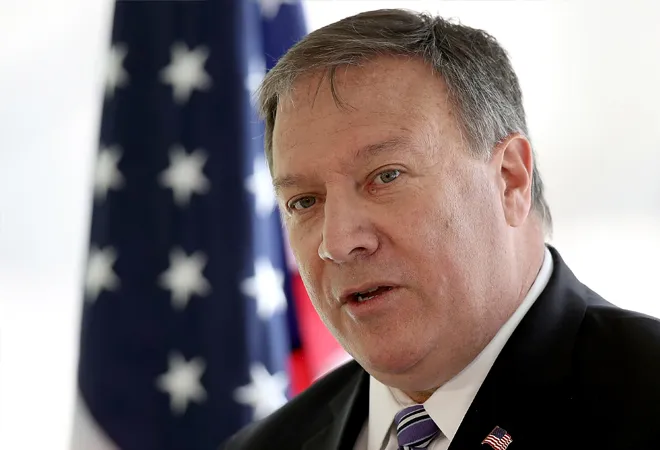
Ahead of his visit to India on 25-26 June, US Secretary of State Mike Pompeo delivered a
policy address on the India-US ties at the India Ideas Summit and 44th Annual Meeting of the US-India Business Council (USIBC) in Washington DC. In underscoring the criticality of the evolving dynamic between the two nations, Secretary Pompeo said, “it’s only natural that the world’s most populous democracy should partner with the world’s oldest democracy to maintain our shared vision throughout the Indo-Pacific.”
This address comes amidst a recent flurry of attention to India’s central position in the US’ strategic calculus. For instance, the recent US Department of Defense
Indo-Pacific Strategy Report underscores the cruciality of the United States “
building new and stronger bonds with nations that share our values across the region, from India to Samoa.” Furthermore, building on the
June 2017 discussions between Prime Minister Narendra Modi and President Donald Trump, the US has now
reportedly agreed to sell surveillance version of the Sea Guardian drones. If the sale goes through, India will be the first non-formal treaty partner of the US to receive the MTCR Category-1 Unmanned Aerial System.
Secretary Pompeo’s upcoming visit to India is set to be marred by US interests coming at odds with India’s Iran oil imports, Generalised System of Preferences (GSP) status, and S-400 purchase from Russia.
Despite this seminal development on India-US defense ties and commendations emanating from the highest levels of the US State Department and the US Department of Defense, Secretary Pompeo’s upcoming visit to India is set to be marred by US interests coming at odds with India’s Iran oil imports, Generalised System of Preferences (GSP) status, and S-400 purchase from Russia.
US prioritising pressure on Iran despite risks to India’s energy security
Analogous to its approach of “
maximum pressure” on North Korea, the Trump administration recently doubled down on Iran’s oil exports. By not continuing
sanctions waivers for India and seven other Iran oil-importing countries, the US’ attempt to coax Iran back to the negotiating table bought India’s energy security into the crosshairs.
Not only has Iran been India’s third-largest source of oil, it has also extended benefits to India such as “
a 60-day credit period, free insurance, and cheaper freight.”
However, the US seems unfettered as the decision to not extend waivers stems from the Trump administration’s increased focus on its Iran policy. Some of them being, efficacy of Trump’s “maximum pressure” approach with North Korea
coming into question, known Iran hawk US National Security Advisor John Bolton
centralising the National Security Council’s consultative processes, and Iran not
outrightly violating core tenets of the landmark 2015 nuclear deal since Trump’s withdrawal from the same. The focus on Iran has peaked to a point that the US is now reportedly weighing sanctions even against “
the Iranian financial body set up as a go-between for humanitarian trade with Europe” –– poised to rake up another round of transatlantic tensions.
US disregarding the strategic relevance of India’s GSP status
The US recently
revoked India’s designation as a ‘beneficiary developing country’ under the GSP. India was the largest beneficiary of the program in 2017 with duty free access given to goods worth $5.7 billion going into the US. Owing to this status,
over 12 percent of all Indian exports to the US in 2017 benefited under the GSP scheme.
The US’ move seems to be aimed at forcing India to rethink its approach to trade negotiations – which have dragged on for over two years much to US trade representatives' frustration.
Many even warned that the US action could be counter -intuitive towards the Trump administration's broader “trade war” with China. For instance, according to a
report by the Coalition for GSP, as US imports from China have decreased under the Section 301 tariffs, imports of some of those products from GSP-status countries “
increased the most in the first quarter of 2019”. Specifically, imports from India of Section 301 list products “
increased by USD 193 million (18 percent).”
However, the US’ move seems to be aimed at forcing India to rethink its approach to trade negotiations –– which have dragged on for over two years much to US trade representatives' frustration. The negotiations have stalled, as India has approached the trade negotiations as a matter of Trump’s fixation on trade deficits. Whereas, US negotiators have approached negotiations with India with regards to, what they view as long-standing issues in bilateral trade such as market access for dairy products and price caps on medical equipment.
US leveraging prospect of CAATSA sanctions over India’s S-400 purchase
Last year, despite the threat of sanctions under the US legislation
Countering America’s Adversaries Through Sanctions Act (CAATSA), India inked the deal to purchase five S-400 batteries worth
around $5.43 billion. Eventually, contention with the US over the purchase stood dampened as the US Congress provided provisions for waiver to India, Vietnam and Indonesia under
Section 231 of CAATSA.
Although, the waiver has to-date not been granted by President Trump, the provision itself overtime came to be seen as Washington according an exception to New Delhi on account of the promising trajectory of bilateral ties between the two nations. In recent months however, the issue seems to have been reignited.
At first, it seemed like the US was reigniting the S-400 issue with India merely to convey the
American resolve to Turkey on its purchase of the S-400, and to avoid any exemptions for India on the matter hindering its
attempts to rein-in Turkey. However, with the US now offering to India
alternate systems (like National Advanced Surface to Air Missile System-II) and
possibly even the F-35 fifth-generation stealth fighter jet, the Trump administration seems to be leveraging the prospect of CAATSA sanctions on India to further its ‘
Buy American’ policy for increased US arms sales.
Sharing the onus of upholding the Carter mantra
As US interests on those issues clash with India’s, the US continues to press on with outstanding strategic developments. For instance, the US is pushing for a “
specific framework to facilitate sharing of critical military technology by American defence firms with their Indian counterparts.” The same is intended to address long-standing roadblocks such as “
liability, intellectual property rights and industrial safety” in case of technology transfers and defense co-production.
As bilateral tensions centred on India’s interests on trade, defense acquisition, and energy security continue, the US seems to be pushing India to also not let irritants on those fronts hijack the rising tempo of strategic ties.
As in the past, through Republican and Democrat administrations, an understated dictum informed the US’ approach to India. In developing an exceptional template for courting a country that abhors formal alignments, the Carter
mantra prescribed Washington to be “
patient as the Indian system works through its responses to US templates, and be flexible.”
Named after Ashton Carter — former Secretary of Defense and architect of the
US-India Defense Technology and Trade Initiative, the approach encompassed the US to focus on harnessing strategic ties and not let differences on other fronts like trade to crowd out
minimal-yet-positive developments.
Under Trump however, the US seems to be doubling down on that approach by shifting the onus also onto India. As bilateral tensions centred on India’s interests on trade, defense acquisition, and energy security continue, the US seems to be pushing India to also not let irritants on those fronts hijack the rising tempo of strategic ties.
Therefore, India’s challenge to ascertain the now increasingly apparent thin line between its strategic alignment with the US and its quest for maintaining strategic autonomy, will cloud Secretary Pompeo’s upcoming visit.
The views expressed above belong to the author(s). ORF research and analyses now available on Telegram! Click here to access our curated content — blogs, longforms and interviews.



 Ahead of his visit to India on 25-26 June, US Secretary of State Mike Pompeo delivered a
Ahead of his visit to India on 25-26 June, US Secretary of State Mike Pompeo delivered a  PREV
PREV


